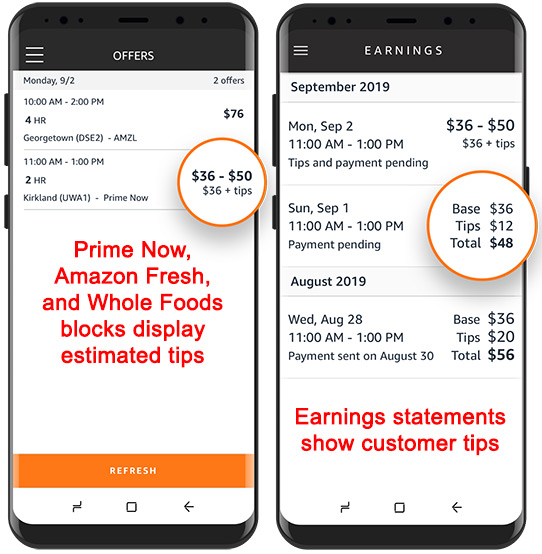What Amazon Drivers Can Expect in Terms of Weekly Pay
As an Amazon driver, understanding the factors that influence weekly earnings is crucial for managing expectations and making informed decisions about one’s career. Amazon drivers play a vital role in the e-commerce giant’s logistics network, ensuring timely and efficient delivery of packages to customers across the globe. With the rise of online shopping, the demand for reliable and skilled drivers has increased, making it an attractive career option for many. But how much does an Amazon driver make a week?
The answer to this question depends on various factors, including location, experience, and type of vehicle. Amazon drivers can expect to earn a competitive hourly wage, with opportunities for overtime and bonuses during peak periods. However, the actual take-home pay can vary significantly depending on individual circumstances. In this article, we will delve into the details of Amazon driver pay, exploring the different components that make up their weekly earnings and providing insights into how drivers can maximize their income.
Amazon drivers can expect to earn an average weekly pay ranging from $800 to $1,200, although this figure can vary depending on the location and the driver’s level of experience. For instance, drivers in urban areas tend to earn more than those in rural areas, due to the higher demand for delivery services. Similarly, experienced drivers who have been with Amazon for several years can expect to earn higher wages than new recruits.
Despite the variations in pay, Amazon drivers can take comfort in knowing that their earnings are competitive with other logistics and transportation companies. Moreover, Amazon offers a range of benefits, including health insurance, retirement plans, and paid time off, which can enhance their overall compensation package.
In the following sections, we will explore the different components of Amazon driver pay, including base pay, tips, and incentives. We will also provide tips and strategies for drivers to maximize their earnings and share real-life examples of Amazon drivers who have shared their experiences online.
How Amazon Driver Pay is Calculated
Amazon uses a complex algorithm to calculate driver earnings, taking into account various factors that impact the delivery process. The algorithm considers factors such as distance, time, and package weight to determine the driver’s earnings for each delivery. This approach ensures that drivers are fairly compensated for their work, regardless of the specific delivery requirements.
The Amazon driver pay structure consists of three main components: base pay, tips, and incentives. Base pay is the driver’s hourly wage, which varies depending on the location and the driver’s level of experience. Tips are additional earnings that drivers can receive from customers for providing excellent service. Incentives, on the other hand, are bonuses that Amazon offers to drivers for meeting specific performance targets, such as completing a certain number of deliveries within a set timeframe.
Amazon’s algorithm also takes into account the driver’s route efficiency, which is measured by the number of deliveries completed per hour. Drivers who optimize their routes and complete deliveries quickly and efficiently can earn higher incentives and tips, which can significantly boost their weekly earnings.
For example, Amazon drivers who work in urban areas may earn a higher base pay due to the higher demand for delivery services. However, they may also face more traffic and congestion, which can impact their route efficiency and earnings. On the other hand, drivers who work in rural areas may earn a lower base pay, but they may have fewer traffic and congestion issues, which can result in higher incentives and tips.
Understanding how Amazon driver pay is calculated is essential for drivers to maximize their earnings potential. By optimizing their routes, providing excellent customer service, and taking advantage of peak pay opportunities, drivers can increase their weekly earnings and achieve their financial goals.
Average Weekly Earnings for Amazon Drivers
According to data from Glassdoor, a popular job search website, the average weekly earnings for Amazon drivers in the United States range from $800 to $1,200. However, these figures can vary significantly depending on the location and the driver’s level of experience.
For example, Amazon drivers in urban areas such as New York City and San Francisco tend to earn higher weekly earnings, with averages ranging from $1,000 to $1,500. In contrast, drivers in rural areas may earn lower weekly earnings, with averages ranging from $600 to $1,000.
Experience also plays a significant role in determining Amazon driver earnings. Drivers with more experience tend to earn higher weekly earnings, with averages ranging from $1,200 to $1,800. In contrast, new drivers may earn lower weekly earnings, with averages ranging from $800 to $1,200.
It’s worth noting that these figures are based on national averages and can vary depending on individual circumstances. Additionally, these figures do not include tips and incentives, which can significantly impact a driver’s weekly earnings.
A study by Indeed, a job search website, found that Amazon drivers in the United States earn an average of $18.49 per hour. However, this figure can vary depending on the location and the driver’s level of experience.
Another study by the website, Amazon Driver Forum, found that Amazon drivers can earn up to $2,000 per week during peak seasons, such as the holiday season. However, this figure is not typical and may vary depending on individual circumstances.
Overall, while there is no one-size-fits-all answer to the question of how much Amazon drivers make a week, these figures provide a general idea of what drivers can expect to earn. However, it’s essential to keep in mind that individual circumstances can significantly impact earnings.
Maximizing Earnings as an Amazon Driver
As an Amazon driver, there are several strategies that can be employed to maximize earnings. One of the most effective ways to increase earnings is to optimize routes. By taking the most efficient route, drivers can complete more deliveries in less time, which can result in higher earnings.
Providing excellent customer service is also crucial for maximizing earnings. Amazon drivers who receive high ratings from customers are more likely to receive tips and incentives, which can significantly boost their earnings. Additionally, drivers who provide excellent customer service are more likely to be offered peak pay opportunities, which can result in even higher earnings.
Another way to maximize earnings is to take advantage of peak pay opportunities. Amazon offers peak pay to drivers who work during busy periods, such as holidays and special events. By working during these periods, drivers can earn higher hourly rates and bonuses, which can result in significantly higher earnings.
Additionally, Amazon drivers can also maximize their earnings by reducing their expenses. By keeping their vehicles well-maintained and fuel-efficient, drivers can reduce their fuel costs and other expenses, which can result in higher earnings.
It’s also important for Amazon drivers to stay organized and manage their time effectively. By using tools such as route optimization software and time management apps, drivers can stay on top of their deliveries and ensure that they are completing them in the most efficient way possible.
Finally, Amazon drivers can also maximize their earnings by taking advantage of Amazon’s incentive programs. Amazon offers a range of incentive programs, including bonuses for completing a certain number of deliveries within a set timeframe, and rewards for providing excellent customer service. By taking advantage of these programs, drivers can earn even higher earnings and achieve their financial goals.
How to Estimate Your Weekly Earnings as an Amazon Driver
Estimating weekly earnings as an Amazon driver can be a complex task, as it depends on various factors such as location, experience, and type of vehicle. However, by following a simple step-by-step guide, drivers can make an informed estimate of their weekly earnings.
Step 1: Calculate Base Pay
Base pay is the hourly wage that Amazon drivers earn for their work. To calculate base pay, drivers can use the following formula:
Base Pay = Hourly Wage x Number of Hours Worked
For example, if an Amazon driver earns an hourly wage of $15 and works 40 hours per week, their base pay would be:
Base Pay = $15 x 40 hours = $600 per week
Step 2: Calculate Tips and Incentives
Tips and incentives are additional earnings that Amazon drivers can receive for providing excellent customer service and completing deliveries efficiently. To calculate tips and incentives, drivers can use the following formula:
Tips and Incentives = Average Tip per Delivery x Number of Deliveries per Week + Incentives per Week
For example, if an Amazon driver receives an average tip of $2 per delivery and completes 100 deliveries per week, their tips would be:
Tips = $2 x 100 deliveries = $200 per week
Step 3: Calculate Total Weekly Earnings
Total weekly earnings are the sum of base pay, tips, and incentives. To calculate total weekly earnings, drivers can use the following formula:
Total Weekly Earnings = Base Pay + Tips and Incentives
For example, if an Amazon driver earns a base pay of $600 per week, tips of $200 per week, and incentives of $100 per week, their total weekly earnings would be:
Total Weekly Earnings = $600 + $200 + $100 = $900 per week
By following these simple steps, Amazon drivers can estimate their weekly earnings and make informed decisions about their career.
Real-Life Examples of Amazon Driver Earnings
To illustrate the potential earning range for Amazon drivers, let’s take a look at some real-life examples of drivers who have shared their earnings online.
For example, a driver in New York City reported earning an average of $1,200 per week, with some weeks reaching as high as $1,500. This driver attributed their high earnings to their ability to navigate the city’s busy streets efficiently and provide excellent customer service.
Another driver in Los Angeles reported earning an average of $1,000 per week, with some weeks reaching as high as $1,200. This driver credited their high earnings to their ability to optimize their routes and take advantage of peak pay opportunities.
A driver in Chicago reported earning an average of $900 per week, with some weeks reaching as high as $1,100. This driver attributed their high earnings to their ability to provide excellent customer service and work efficiently during peak hours.
These examples illustrate the potential earning range for Amazon drivers and highlight the importance of factors such as location, experience, and customer service in determining earnings.
It’s worth noting that these figures are not typical and may vary depending on individual circumstances. However, they do provide a glimpse into the potential earning range for Amazon drivers and can help inform decisions about pursuing a career as an Amazon driver.
By understanding the factors that influence Amazon driver earnings and taking steps to optimize their routes, provide excellent customer service, and take advantage of peak pay opportunities, drivers can increase their earning potential and achieve their financial goals.
Factors That Can Impact Amazon Driver Earnings
While Amazon driver earnings can be influenced by a variety of factors, there are several external factors that can impact earnings. Fuel prices, traffic, and weather conditions are just a few examples of factors that can affect Amazon driver earnings.
Fuel prices, for example, can have a significant impact on Amazon driver earnings. As fuel prices rise, drivers may see a decrease in their earnings due to the increased cost of fuel. However, Amazon drivers can adapt to this factor by optimizing their routes and reducing fuel consumption.
Traffic is another factor that can impact Amazon driver earnings. Heavy traffic can lead to longer delivery times, which can result in lower earnings. However, Amazon drivers can adapt to this factor by using traffic avoidance strategies and optimizing their routes.
Weather conditions can also impact Amazon driver earnings. Inclement weather, such as heavy rain or snow, can make delivery times longer and more difficult, resulting in lower earnings. However, Amazon drivers can adapt to this factor by using weather-resistant equipment and optimizing their routes.
Additionally, Amazon drivers can also be impacted by factors such as vehicle maintenance and repair costs. Regular maintenance and repair of vehicles can help to reduce costs and increase earnings.
By understanding these factors and adapting to them, Amazon drivers can minimize their impact on earnings and maximize their earning potential.
It’s also worth noting that Amazon provides various tools and resources to help drivers manage these factors and optimize their earnings. For example, Amazon’s routing algorithm takes into account traffic and weather conditions to provide the most efficient routes possible.
By taking advantage of these tools and resources, Amazon drivers can increase their earning potential and achieve their financial goals.
Conclusion: Understanding Amazon Driver Earnings
In conclusion, Amazon driver earnings can vary significantly depending on a range of factors, including location, experience, and type of vehicle. By understanding these factors and how they impact earnings, drivers can make informed decisions about their own earning potential and take steps to maximize their earnings.
As we’ve seen, Amazon driver pay is calculated using a complex algorithm that takes into account factors like distance, time, and package weight. Drivers can also earn tips and incentives for providing excellent customer service and completing deliveries efficiently.
While there are various factors that can impact Amazon driver earnings, such as fuel prices, traffic, and weather conditions, drivers can adapt to these factors by optimizing their routes, using fuel-efficient vehicles, and taking advantage of peak pay opportunities.
By understanding the factors that influence Amazon driver earnings and taking steps to maximize their earnings, drivers can achieve their financial goals and enjoy a successful and rewarding career as an Amazon driver.
Whether you’re considering a career as an Amazon driver or are already driving for the company, we hope this article has provided you with valuable insights into the world of Amazon driver earnings. By understanding how much Amazon drivers can make a week, you can make informed decisions about your own earning potential and take steps to achieve your financial goals.






